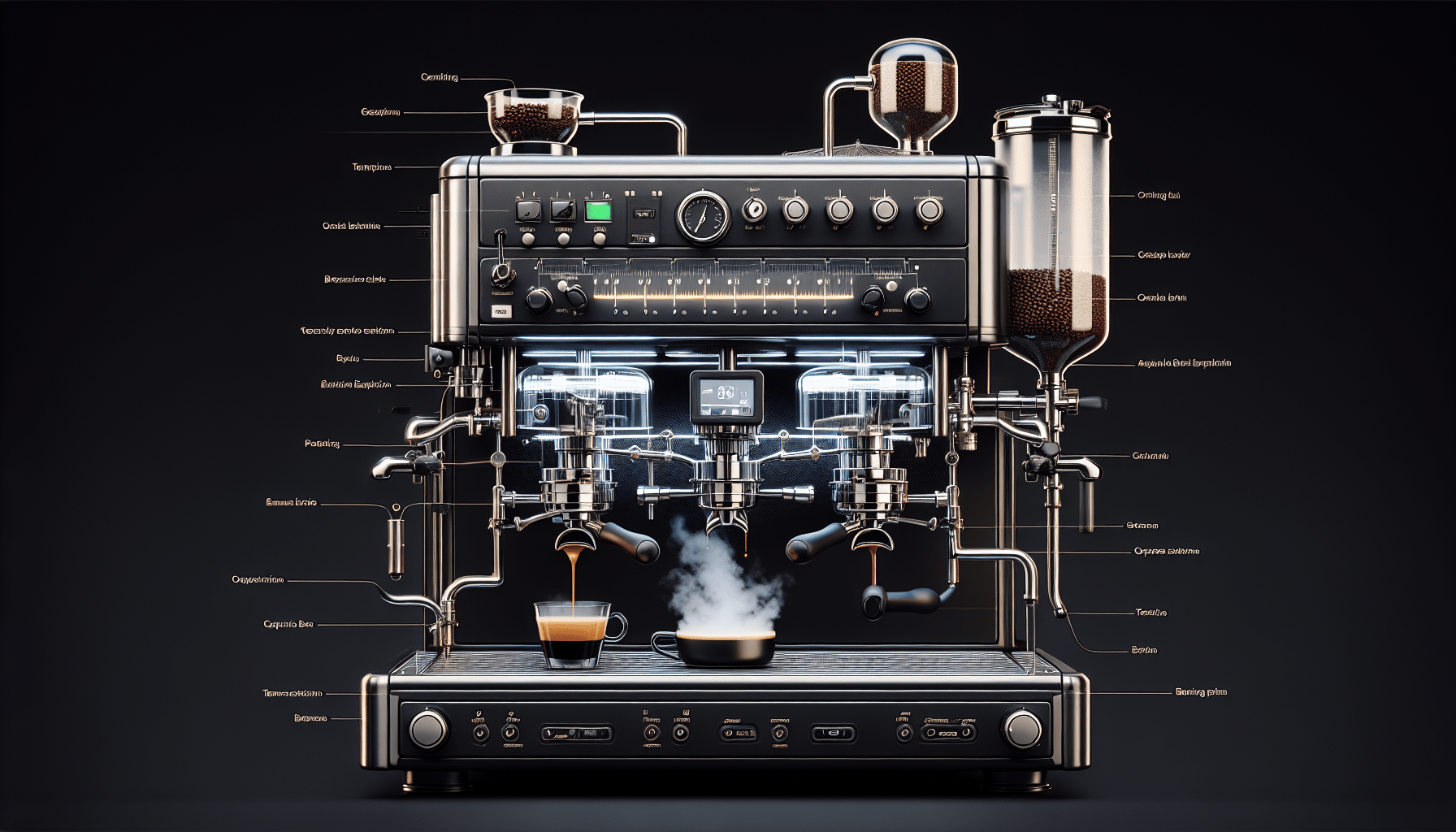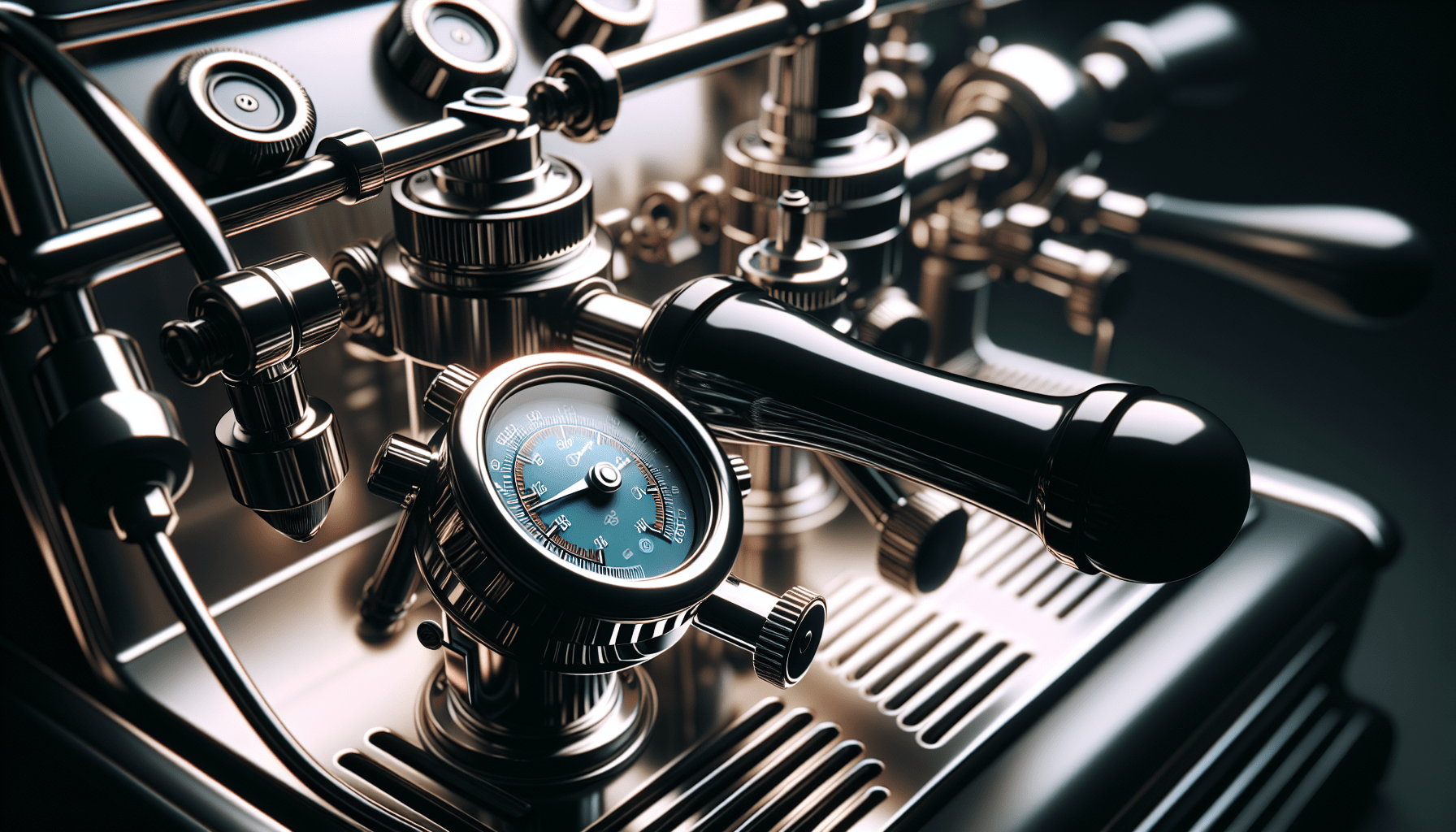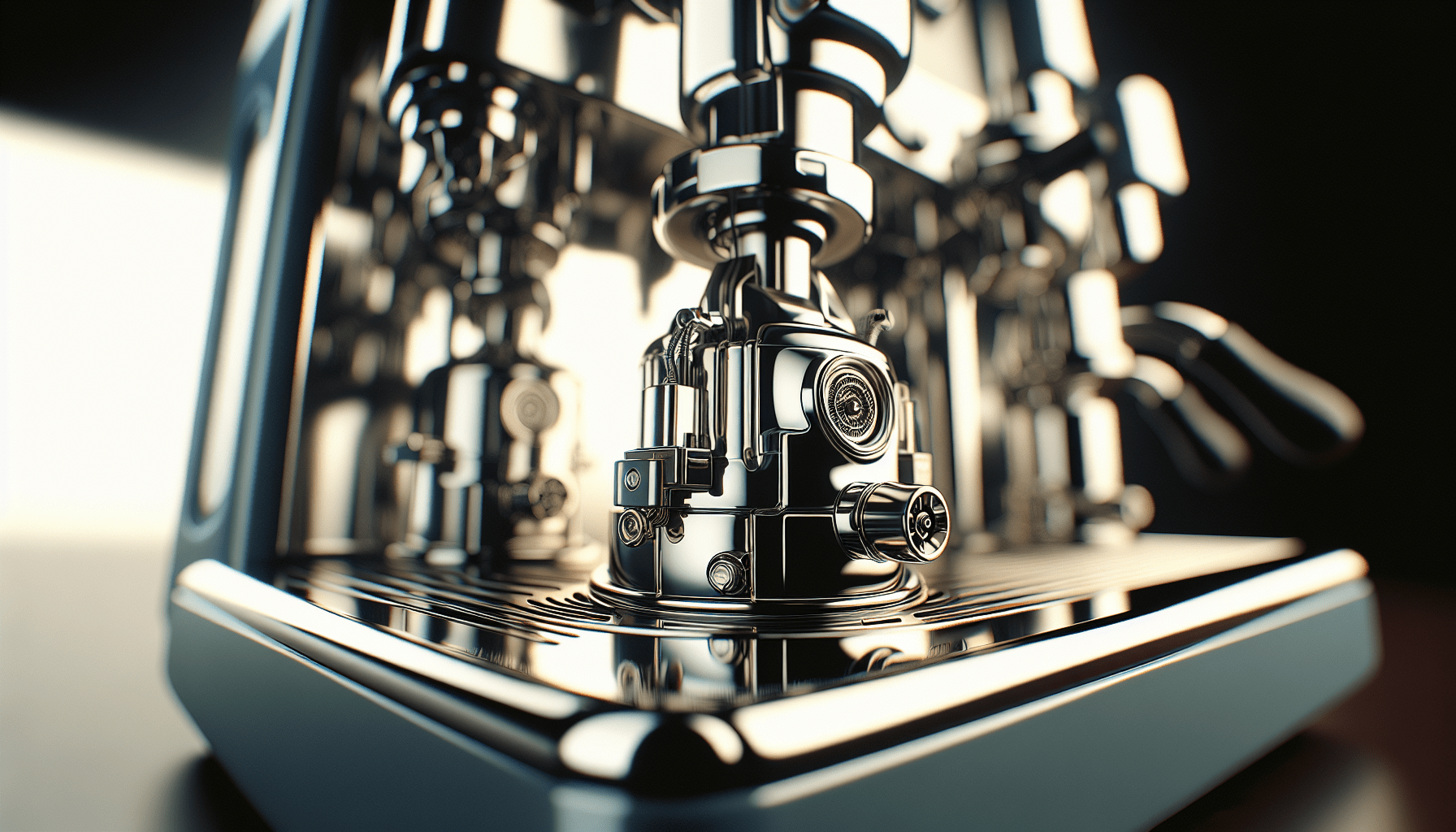So you’ve just purchased a semi-automatic espresso machine and you’re ready to embark on your journey to becoming a home barista. But before you can create that perfect, aromatic cup of espresso, it’s essential to understand the portafilters used in your machine. These small yet mighty devices play a crucial role in the extraction process, ensuring a balanced and flavorful shot of espresso. In this article, we’ll explore the different types of portafilters commonly used in semi-automatic espresso machines, helping you become acquainted with the key components of your brewing arsenal. So grab a cup of your favorite espresso and let’s dive into the world of portafilters!
Types of Portafilters
Standard Portafilter
The standard portafilter is the most common type used in semi-automatic espresso machines. It consists of a handle, a basket, and a spout. The handle is where you grip the portafilter, and it is usually made of plastic or metal. The basket holds the coffee grounds and is attached to the bottom of the handle. Finally, the spout is where the espresso flows out of the portafilter into the cup. The standard portafilter is a reliable and versatile option for most espresso enthusiasts.
Bottomless (Naked) Portafilter
A bottomless portafilter, also known as a naked portafilter, is a specialized type of portafilter that does not have a spout. Instead, it has an open bottom, allowing you to see the coffee as it is being extracted. This type of portafilter is popular among baristas and coffee enthusiasts because it provides greater visibility and control over the extraction process. The lack of a spout also allows for easier cleaning and maintenance. Bottomless portafilters are often used for latte art and to ensure an even extraction.
Components of a Portafilter
Handle
The handle of a portafilter is where you grip it when preparing espresso. It is usually made of plastic or metal and is designed to be comfortable and easy to hold. Some handles have ergonomic shapes or rubber grips to provide a secure and comfortable grip. The handle is an important component as it allows you to easily attach and detach the portafilter from the espresso machine.
Basket
The basket is the part of the portafilter that holds the coffee grounds. It is typically made of stainless steel and comes in different sizes to accommodate different amounts of coffee. The basket is designed to distribute the water evenly over the coffee grounds during the extraction process, resulting in a balanced and flavorful espresso. It is important to choose the right size basket for your needs, whether you prefer a single shot or a double shot of espresso.
Spout
The spout is the part of the portafilter where the espresso flows out into the cup. It is usually made of stainless steel and has one or two openings, depending on whether it is a single or double shot portafilter. The spout is designed to direct the flow of espresso and prevent splashing. It also allows you to easily pour the espresso into the cup without any spills or mess. Some portafilters have removable spouts, which can be useful for cleaning and maintenance.
Material of Portafilters
Stainless Steel
Stainless steel is a common material used for portafilters due to its durability, corrosion resistance, and heat retention properties. Stainless steel portafilters are often preferred by professional baristas as they can withstand high temperatures and heavy use without warping or deforming. They are also easy to clean and maintain, making them a practical choice for home espresso enthusiasts.
Brass
Brass is another popular material used for portafilters, particularly among traditionalists and espresso purists. Brass portafilters have good heat retention properties, which can contribute to a more stable and consistent extraction. They are also known for their aesthetic appeal, as brass develops a unique patina over time. However, brass portafilters require more frequent cleaning and maintenance to prevent tarnishing and oxidation.
Size of Portafilters
Single Shot
A single shot portafilter is designed to hold enough coffee grounds for a single serving of espresso. It typically has a smaller basket and spout than a double shot portafilter. Single shot portafilters are suitable for those who prefer a smaller, concentrated dose of espresso, or for those who want to limit their caffeine intake.
Double Shot
A double shot portafilter is designed to hold enough coffee grounds for two servings of espresso. It has a larger basket and spout than a single shot portafilter, allowing for a larger volume of espresso to be extracted at once. Double shot portafilters are ideal for those who enjoy a stronger and more substantial cup of espresso, or for those who want to share their coffee with a friend or loved one.
The Importance of Portafilter Design
Extraction Quality
The design of the portafilter plays a crucial role in the quality of the espresso extraction. A well-designed portafilter ensures that the water evenly distributes over the coffee grounds, resulting in a balanced and flavorful cup of espresso. It also helps to maintain a consistent brew temperature, which is essential for extracting the optimal flavors from the coffee. The shape and size of the basket, as well as the material of the portafilter, can all influence the extraction quality.
Ease of Use
A well-designed portafilter should be easy to use and handle. It should have a comfortable and ergonomic handle that allows for a secure grip. The attachment and detachment of the portafilter from the espresso machine should be smooth and effortless. The spout should be designed in a way that prevents splashing and ensures a clean, controlled pour. Additionally, a bottomless portafilter can provide greater visibility and control over the extraction process, making it easier to achieve the desired results.
Aesthetics
While aesthetics may not directly impact the quality of the espresso, they can certainly enhance the overall coffee experience. Many coffee enthusiasts appreciate a well-crafted and visually appealing portafilter as it adds to the enjoyment of making and serving espresso. Portafilters with wooden handles or unique finishes can add a touch of elegance and style to your espresso setup.
Understanding the Basket
Filter Size
The size of the basket, also known as the filter size, is an important consideration when using a portafilter. It determines the amount of coffee that can be extracted and the strength of the espresso. Most standard portafilters have a 58mm diameter, which is suitable for both single and double shots. However, there are also smaller and larger baskets available to accommodate different brewing preferences. It is essential to choose the right size basket for your needs to ensure a balanced and flavorful extraction.
Distribution
Proper distribution of coffee grounds in the basket is crucial for even extraction and to avoid channeling. Channeling is when the water finds a path of least resistance through the coffee grounds, resulting in an uneven extraction and a poorly balanced espresso. To achieve an even distribution, it is important to level the coffee grounds in the basket using a distribution tool or by tapping the portafilter gently. This will help to ensure that the water flows through the coffee grounds evenly, extracting the flavors and aromas in a consistent manner.
Maintaining and Cleaning Portafilters
Backflushing
Backflushing is a cleaning method that involves using water and detergent to remove coffee oils and residue from the portafilter and the espresso machine’s group head. It is typically done with a blind filter, which is a basket without any holes, to contain the water and detergent mixture. Backflushing should be done regularly, especially if you use your espresso machine frequently, to keep the portafilter clean and to prevent any buildup that could affect the taste of the espresso.
Soaking
Soaking the portafilter in a solution of water and cleaning detergent can help remove stubborn coffee stains and oils. It is particularly useful for brass portafilters, as they tend to tarnish and develop oxidation over time. By soaking the portafilter, you can effectively break down these stains and restore the portafilter’s shine and cleanliness. After soaking, make sure to rinse the portafilter thoroughly with clean water before using it again.
Scrubbing
Regularly scrubbing the portafilter with a brush or sponge is essential for maintaining its cleanliness and longevity. Pay close attention to the basket and spout, as coffee grounds can get trapped in these areas and affect the extraction quality. Use a mild detergent and warm water to clean the portafilter, and avoid abrasive or harsh chemicals that could damage the material or finish. Rinse the portafilter thoroughly and allow it to dry completely before storing or using it again.
Modifications and Upgrades for Portafilters
Aftermarket Baskets
Aftermarket baskets, also known as precision baskets, are an upgrade option for those seeking to improve the extraction quality of their espresso. These baskets are designed to have more precise hole patterns and greater consistency in hole size, resulting in a more even extraction. They can help enhance the flavors and aromas in the espresso, providing a more refined and enjoyable coffee experience.
Wooden Handles
Wooden handles are a popular modification for portafilters as they add a unique and stylish touch to the espresso setup. They are available in different types of wood and finishes, allowing you to customize the look of your portafilter. Wooden handles also provide a comfortable grip and can help insulate the handle, keeping it cool to the touch. If you are considering a wooden handle for your portafilter, make sure to choose a type of wood that is resistant to moisture and heat.
Pressure Profiling
Pressure profiling is a more advanced modification that involves adjusting the pressure during the espresso extraction process. This allows for greater control over the flavors and extraction characteristics of the coffee. Some portafilters and espresso machines come with pressure profiling capabilities built-in, while others may require additional modifications or attachments. Pressure profiling is a technique often used by professional baristas and coffee enthusiasts looking to experiment and fine-tune their espresso brewing.
Replacing Portafilter Parts
Replacing the Basket
Over time, the basket of a portafilter may wear out or become damaged. It is important to regularly inspect the basket for any signs of wear, such as loose or bent edges, as this can affect the extraction quality. If you notice any issues, it is advisable to replace the basket with a new one. Make sure to choose a replacement basket that is compatible with your portafilter’s size and design to ensure a proper fit and optimal performance.
Replacing the Handle
If the handle of your portafilter becomes cracked, broken, or uncomfortable to use, it may be time to replace it. Handles are commonly available as replacement parts, and they can be easily detached from the portafilter and replaced with a new one. When choosing a replacement handle, consider the material, shape, and grip to ensure that it suits your preferences and needs.
Conclusion
Summary
In conclusion, portafilters are essential components of semi-automatic espresso machines, allowing you to extract flavorful and aromatic espresso at home or in a café setting. The standard portafilter is the most common type, while the bottomless portafilter offers greater control and visibility. The handle, basket, and spout are the main components of a portafilter, with stainless steel and brass being popular material choices.
The size of the portafilter, whether single shot or double shot, determines the amount of coffee it can hold. Portafilter design is important for extraction quality, ease of use, and aesthetics. The basket size and proper distribution of coffee grounds impact the extraction process. Maintenance and cleaning of portafilters involve backflushing, soaking, and regular scrubbing.
Modifications and upgrades for portafilters include aftermarket baskets, wooden handles, and pressure profiling. When parts of a portafilter wear out or become damaged, they can be replaced, such as the basket or handle. Overall, understanding the different types, components, materials, sizes, and maintenance of portafilters is crucial for achieving a great espresso experience.
Closing Thoughts
Remember, selecting the right portafilter for your espresso setup is a matter of personal preference and brewing goals. Whether you choose a standard or bottomless portafilter, stainless steel or brass, single shot or double shot, the most important thing is to enjoy the process and savor the delicious results. With proper care and maintenance, your portafilter will continue to deliver exceptional espresso for years to come. So, go ahead, perfect your technique, and create barista-worthy espresso with your trusty portafilter.



